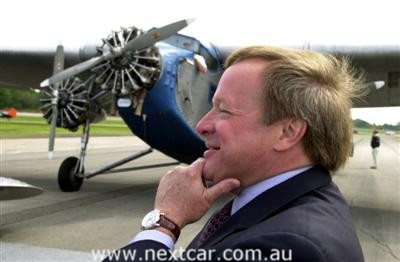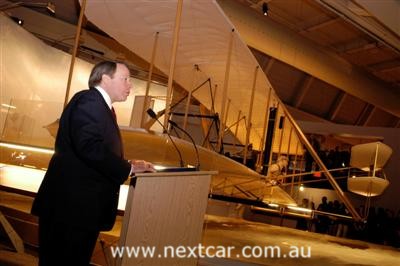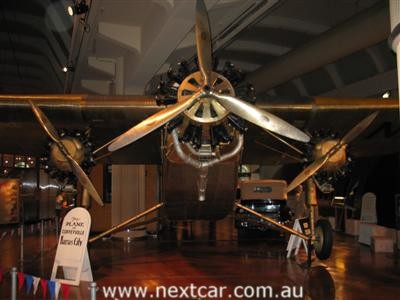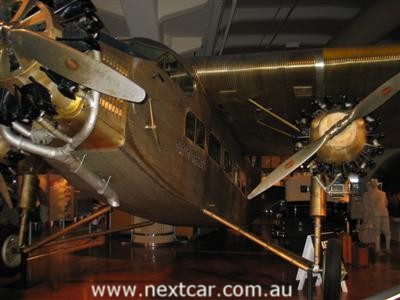Henry Ford and aviation
|

With a 1929 Ford Tri-Motor behind him, Edsel B. Ford
II, great-grandson of Henry Ford, watched the historic landing of five vintage aircraft 9th June
2003, at Ford Motor Company's Dearborn Proving Grounds in USA. It was the first time in 56 years that
the test track was used as an airport. The track and surrounding facilities sit on what was once Ford
Airport, which opened in 1925 as the world's first modern airport.

Edsel B. Ford II donates on behalf of Ford Motor
Company the 1903 Wright Flyer reproduction to The Henry Ford for its Heroes of the Sky exhibit in
2004.

A 2009 image at the Henry Ford Museum in Dearborn (Michigan, USA).

A 2009 image at the Henry Ford Museum in Dearborn (Michigan, USA).
|
|
|
Home >
News >
Ford
Related stories:
Henry Ford
31st July, 2011
Henry Ford and car racing
31st July, 2011
Henry Ford and country music
31st July, 2011
31st July, 2011
It was Henry Ford who pioneered the successful
adaptation of the basic concept of the airplane and brought aviation and its advantages closer to the
reach of the average citizen. It was his efforts in developing suitable aircraft to serve the public,
then building public confidence in their reliability, safety and necessity that put the American
nation in the air.
Henry Ford's first involvement in aviation came in 1909, just six years after the Wright brothers'
first powered flight, when he helped his son Edsel and friends build a primitive monoplane powered by
a Ford Model T engine.
In 1923, Edsel Ford invested in the Stout Metal Airplane Company, which built the "Air Pullman,"
the world's first all-metal, single-engine high cantilever wing monoplane. From this start, with
additional help from Ford Motor Company, the all-metal Stout 2-AT "Air Transport" plane was
developed. With it, Ford Motor Company initiated Ford Air Transport Service in 1925 – the world's
first regularly scheduled commercial airline devoted to the business needs of a single company.
In January 1925, Henry Ford opened Ford Airport at Dearborn, Michigan. It was the first modern
airport, boasting the first concrete runway, hangars, dirigible mooring mast, weather station, radio
shack for communicating with pilots and terminal facilities for passengers. It also included a
restaurant and hotel facilities, plus limousine service to downtown Detroit.
To promote public confidence in commercial aircraft, Ford Motor Company sponsored a series of
"Reliability Tours" that began at Ford Airport and involved numerous aircraft flying several thousand
miles with stops at various cities. These tours attracted thousands of spectators and generated
public interest in private and commercial aircraft.
In 1925, Henry Ford formed the Stout Metal Airplane Division of the Ford Motor Company. As a
result, the sale of Ford-built all-metal single-engine monoplanes began to the young struggling
airmail, express and passenger airlines. This same year, the first experimental Ford Tri-Motor was
built. In 1926 the first Wright "Whirlwind" engine equipped Ford 4-AT Tri-Motor came onto the market.
It represented a tremendous technological advance over existing aircraft and it enabled Ford's new
Airplane Manufacturing Division to become the world's largest manufacturer of commercial aircraft.
Airlines quickly abandoned their primitive aircraft capable of only carrying airmail and one or two
passengers and flocked to buy the Ford Tri-Motor. They were soon used to establish the first
transcontinental air service.
Ford Motor Company's involvement in aviation also played an important role during times of war.
During World War I, Ford Motor Company mass-produced the American-designed "Liberty" aircraft engine
and developed engines for the Kettering "Bug," America's first guided missile. After the war Henry
Ford became interested in dirigibles and formed the Airplane Development Division, which pioneered in
the development of the world's first metal-clad airship. During World War II, Henry Ford turned his
energy toward building thousands of Pratt & Whitney "Double Wasp" aircraft engines and B-24
"Liberator" bombers.
For his pioneering efforts, Henry Ford was inducted into the National Aviation Hall of Fame in
1984 and on 17th December, 2002, recognised as one of the nation's top aviation pioneers by the U.S.
Centennial of Flight Commission.
Ford Motor Company continued its ties to aviation through its presenting sponsorship of EAA's
Countdown to Kitty Hawk, a centennial celebration of the Wright brothers’ first powered flight — an
innovation that changed the world. Led by EAA, presented by Ford Motor Company and supported by
Microsoft Flight Simulator and Eclipse Aviation, the year long series of events honours the
innovation and determination it takes to make world-changing dreams a reality. Countdown to Kitty Hawk
featured an interactive touring pavilion and the world’s most-accurate 1903 Wright Flyer reproduction
that exclusively re-enacted the Wright brothers’ first flight at Kitty Hawk, North Carolina, on 17th
December, 2003 — exactly 100 years later.
Ford Airport eventually became the 'proving ground' for Ford Motor Company.
|